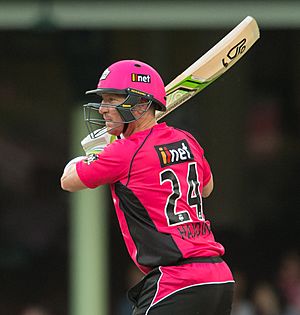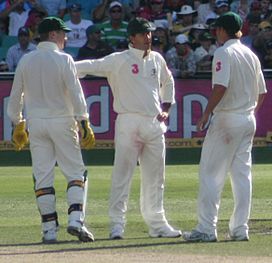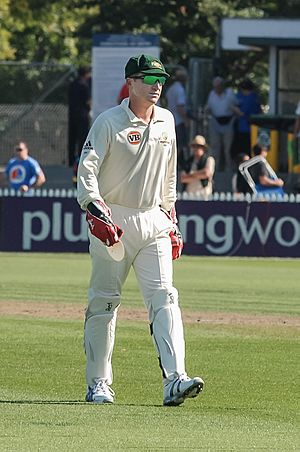Brad Haddin facts for kids

Haddin playing for the Sixers in BBL06
|
||||||||||||||||||||||||||||||||||||
| Personal information | ||||||||||||||||||||||||||||||||||||
|---|---|---|---|---|---|---|---|---|---|---|---|---|---|---|---|---|---|---|---|---|---|---|---|---|---|---|---|---|---|---|---|---|---|---|---|---|
| Full name |
Bradley James Haddin
|
|||||||||||||||||||||||||||||||||||
| Born | 23 October 1977 Cowra, New South Wales |
|||||||||||||||||||||||||||||||||||
| Nickname | BJ, Hadds | |||||||||||||||||||||||||||||||||||
| Height | 177 cm (5 ft 10 in) | |||||||||||||||||||||||||||||||||||
| Batting | Right-handed | |||||||||||||||||||||||||||||||||||
| Role | Wicket-keeper-batter | |||||||||||||||||||||||||||||||||||
| International information | ||||||||||||||||||||||||||||||||||||
| National side |
|
|||||||||||||||||||||||||||||||||||
| Test debut (cap 400) | 22 May 2008 v West Indies | |||||||||||||||||||||||||||||||||||
| Last Test | 12 July 2015 v England | |||||||||||||||||||||||||||||||||||
| ODI debut (cap 144) | 30 January 2001 v Zimbabwe | |||||||||||||||||||||||||||||||||||
| Last ODI | 29 March 2015 v New Zealand | |||||||||||||||||||||||||||||||||||
| ODI shirt no. | 57 | |||||||||||||||||||||||||||||||||||
| T20I debut (cap 16) | 9 January 2006 v South Africa | |||||||||||||||||||||||||||||||||||
| Last T20I | 5 October 2014 v Pakistan | |||||||||||||||||||||||||||||||||||
| T20I shirt no. | 57 | |||||||||||||||||||||||||||||||||||
| Domestic team information | ||||||||||||||||||||||||||||||||||||
| Years | Team | |||||||||||||||||||||||||||||||||||
| 1997/98–1998/99 | ACT Comets | |||||||||||||||||||||||||||||||||||
| 1999/00–2014/15 | New South Wales | |||||||||||||||||||||||||||||||||||
| 2011 | Kolkata Knight Riders | |||||||||||||||||||||||||||||||||||
| 2011/12–2016/17 | Sydney Sixers | |||||||||||||||||||||||||||||||||||
| 2016–2017 | Islamabad United | |||||||||||||||||||||||||||||||||||
| Career statistics | ||||||||||||||||||||||||||||||||||||
|
||||||||||||||||||||||||||||||||||||
|
Medal record
|
||||||||||||||||||||||||||||||||||||
|
Source: ESPNcricinfo, 9 September 2015
|
||||||||||||||||||||||||||||||||||||
Bradley James Haddin, born on October 23, 1977, is a famous Australian former cricketer. He was a vice-captain and coach for Australia's national cricket team. Brad played in all three types of international cricket games.
He played for the New South Wales team in Australia. Brad was a right-handed batsman and a wicket-keeper. He helped Australia win the 2007 Cricket World Cup and the 2015 Cricket World Cup. He also played for the Sydney Sixers in the Big Bash League.
Contents
Playing for Teams in Australia
Brad Haddin's family moved to Queanbeyan in 1989 when he was 12 years old. He played for the Queanbeyan District Cricket Club Juniors until he was 15. Then, he joined the Australian National University Grade Cricket Club. He played in the top team at just 16.
Brad started his professional cricket career with the ACT Comets. This was in the first ever Mercantile Mutual Cup season of 1997–98. In the 1999–2000 season, he joined the New South Wales Blues. He wanted more chances to play cricket. He scored many great runs, including 133 against Victoria.
In November 2015, Haddin played for the ACT Comets again. This was his first time back since the 1998–99 season. He scored 104 runs in his first game. This made him one of only six players to score a century in their debut game for the Comets.
Playing for Teams Around the World
Brad Haddin also played for teams in other countries. In 2011, he played for the Kolkata Knight Riders in the Indian Premier League.
He also played for Islamabad United in the Pakistan Super League. This league was held in the UAE in February 2016. He stayed with the team for the 2017 season too.
Brad Haddin's International Career
In September 2003, Brad Haddin became captain of New South Wales. He took over when Simon Katich was playing for Australia. He often acted as captain after that. He also captained the Australia A team.
For most of his career, Haddin was the main wicket-keeper for Australia A. He was also a backup wicket-keeper for the main Australian team. This was in case Adam Gilchrist was injured or needed a rest.
Brad made his international debut in a One Day International (ODI) game. This was on January 30, 2001, against Zimbabwe in Hobart. He made one stumping and scored 13 runs.
On September 18, 2006, Haddin played against the West Indies. He and Australian captain Mike Hussey made 165 runs together. This was a world record for the sixth wicket in ODIs at that time.
After Gilchrist retired in early 2008, Haddin finally played his first Test match. This was on May 22 against the West Indies in Kingston, Jamaica. He became the 400th player to play Test cricket for Australia.

On February 15, 2009, Haddin became the acting Australian captain. This was for a Twenty20 game against New Zealand. Ricky Ponting was resting, and Michael Clarke was injured.
On March 9, 2010, Haddin scored his second ODI century. He hit 110 runs off 121 balls against New Zealand. He had to miss the 2010 ODI series in England because of an elbow injury.
In November 2010, Haddin scored 136 runs in a Test match against England. This was his third Test century. It helped Australia get a big lead. He scored 360 runs in that series.
In January 2012, Haddin was removed from the ODI team. This was after a difficult 2011 season at home. In October 2012, he was also removed from the Test team. Matthew Wade took his place. However, the national selector said Haddin was still an important player.
Haddin was called back to the Australia team for the 2013 Ashes series. He was named vice-captain and played as wicketkeeper. During this series, Haddin set a new record. He made 29 dismissals as a wicketkeeper, all of them catches. This was the most dismissals in a Test series. Haddin was part of the team that won back the Ashes after four years.
During the 2013–14 Ashes series, Haddin made five half-centuries. This was only the second time a wicket-keeper had done this in a Test series. He also scored 493 runs, which was a record for an Australian wicket-keeper in a series. Haddin scored 118 runs in the Adelaide Test. He and Michael Clarke made a 200-run partnership.
In December 2014, Steve Smith replaced Haddin as vice-captain. This was because Cricket Australia wanted a younger leader for the Test team.
Retirement from Cricket
Brad Haddin retired from One Day International (ODI) cricket in May 2015. This was after the 2015 Cricket World Cup, which his team won.
His Test career ended in July 2015 during the 2015 Ashes series. He missed the second Test because his daughter was unwell. Peter Nevill replaced him and played well. Some people, like former Australian wicket-keeper Ian Healy, thought this was a tough decision.
Brad Haddin wrote a book called My Family Keeper in 2013. It is about his life and his daughter's fight with a type of cancer called neuroblastoma.
After he retired, he became an ambassador for his home ground, the Sydney Cricket Ground (SCG). He announced his retirement from international and first-class cricket on September 9, 2015. In 2024, he was added to the ACT Sport Hall of Fame.
Coaching Career
After his playing career, Brad Haddin became a coach. In 2018, he was appointed as the fielding coach for the Australia national cricket team.
In 2019, Haddin became an assistant coach for Sunrisers Hyderabad. He worked with head coach Trevor Bayliss. In October 2022, Haddin became an assistant coach at Punjab Kings. He worked with Trevor Bayliss there again.


